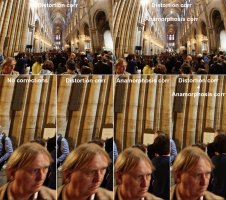i went back to that review and it doesn't seem to be describing what you're saying. and then I went and looked up anamorphosis and it doesn't seem to have to do with the lens.So do I, and although I've never used a Laowa Zero-D lens, it would be ironic to introduce geometric distortion to correct an optically barrel-free UWA lens, to correct the anamorphosis.
Here's what it says:
Based on DxO Labs' exclusive geometric correction technology, DxO ViewPoint allows photographers to easily and efficiently restore the natural proportions of the subjects in their images as an integral part of their workflow.
The deformation of subjects located on the edges of photos is due to the use of wide-angle lenses, and affects numerous situations, particularly social photography (e.g., events, marriages) and photo reportage. Thanks to its dedicated tool, DxO ViewPoint easily fixes this flaw, automatically restoring the natural proportions to distorted faces and bodies to make them look as normal as those in the center of the image.
Upvote
0


